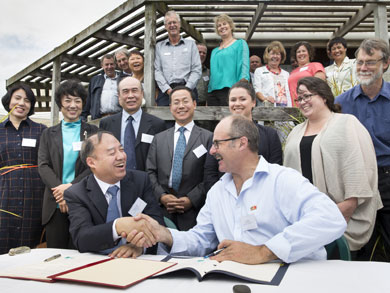DOC and China’s conservation agency agree to protect migratory birds
Archived content: This media release was accurate on the date of publication.
Introduction
DOC and the State Forestry Administration of China have agreed to work together to protect wetlands visited by migratory birds.Date: 18 March 2016

Chinese Vice-Minister Chen Fengzue (L) and DOC Director-General Lou Sanson (R) celebrate signing the agreement to protect migratory birds
The Department of Conservation (DOC) and the State Forestry Administration (SFA) of China have agreed to work together to protect wetlands visited by red knots and bar-tailed godwits during their 12,000 km migratory flights.
DOC Director-General Lou Sanson and Vice-Minister Chen Fengxue, the Chinese Minister responsible for the SFA, on Friday March 18, signed a Memorandum of Arrangement (MOA) on protecting the migratory shorebirds and their habitat.
The MOA was signed at Pūkorokoro Miranda, a Living Water catchment on the Firth of Thames, where thousands of red knots and bar-tailed godwits have spent the summer.
Living Water is a 10 year partnership between Fonterra and DOC, working to improve water quality and the abundance and variety of native wildlife at five wetlands in significant dairying regions.
The coastal wetland at Pūkorokoro Miranda is recognised under the Ramsar Convention as an internationally significant wetland that provide a seasonal home for about 40 species of shorebirds.
The red knots and godwits will soon be leaving Pūkorokoro Miranda to fly 12,000km to their breeding grounds. The red knots breed in Siberia, the godwits breed in Alaska. Both the red knots and godwits will land at wetlands in China, to refuel, before flying on to their breeding sites.
In the MOA, DOC and the SFA of China agree to work together to protect, manage and restore wetlands where red knots, godwits and other migratory shorebirds stop to feed during annual migrations between New Zealand and their breeding grounds.
A key wetland covered by the MOA is a seven kilometre stretch of coastal mudflat and salt ponds at Luannan on Bohai Bay. Fifty per cent of red knots, that spend summer in New Zealand, land at this mudflat after flying non-stop from New Zealand. The red knots refuel on shellfish before flying to their breeding sites in Siberia.
A second wetland covered by the MOA is in the Yalu Jiang Nature Reserve near Dandong on the Chinese border with North Korea. Half the godwits that summer in New Zealand stop over at Yalu Jiang on their way to their breeding sites in Alaska.
“The MOA we’ve signed shows DOC in New Zealand and the SFA in China are committed to working together to ensure these remarkable birds can continue to make these epic journeys,” says DOC Director-General Lou Sanson.
“It is humbling to see these small birds that fly non-stop between our two countries. They form a bridge between New Zealand and China. They connect us as people. We will work together to keep the bridge open,” says Vice-Minister Chen.
The Pūkorokoro-Miranda Naturalists’ Trust began visiting the Yalu Jiang National Nature Reserve 17 years ago. The trust established a sister-site partnership with the reserve in 2004 and has been working towards more formal protection arrangements between New Zealand and China ever since.
“The only way to protect these birds is to protect their habitat, the number of these birds is declining. Signing the MOA marks a significant step in securing a safe flight path for the red knots, godwits and other migratory birds that fly between New Zealand and China,” says Pūkorokoro-Miranda Naturalists’ Trust chair, Gillian Vaughan.
Fonterra Director Social Responsibility Carolyn Mortland says the Co-operative and its farmers are proud to be playing a part in helping protect habitat at Pūkorokoro-Miranda that provides a summer home for red knots and godwits. “This area, and the birds that feed here, are of international significance and our farmers understand the importance of protecting its biodiversity for future generations.”
“For generations our ancestors have watched huahou or red knots and kuaka, the godwits, leave Pūkorokoro in autumn and return in spring. We now know the full extent of their amazing annual flights. We want to ensure this taonga continue to make these journeys for generations to come,” says Ngāti Paoa Iwi Trust Board chair, Gary Thompson.
Backgound information
Fonterra is a global leader in dairy nutrition – the preferred supplier of dairy ingredients to many of the world’s leading food companies. It is also a market leader with its own consumer dairy brands in New Zealand and Australia, Asia, Africa, the Middle East and Latin America.
Fonterra is a farmer-owned co-operative and the largest processor of milk in the world. It is one of the world’s largest investors in dairy research and innovation drawing on generations of dairy expertise to produce more than two million tonnes of dairy ingredients, value added dairy ingredients, specialty ingredients and consumer products for 140 markets.
Contact
Nick Hirst, DOC National Media Team
+64 9 307 4866 or +64 27 704 7773
Anna Johnstone, Fonterra Communications
+ 64 21 458 831 or 24 hour media line: +64 21 507 072

